FIN103: Financial Analysis and Investment Recommendations for JB Hi-Fi
VerifiedAdded on 2023/05/30
|12
|2826
|108
Report
AI Summary
This report provides a comprehensive financial analysis of JB Hi-Fi, a major Australian home entertainment retailer. The analysis covers the quality of earnings, effective tax rate, and various financial ratios like gearing, profitability, and interest coverage ratios. It delves into Earnings Per Share (EPS) and Price-to-Earnings (P/E) ratio calculations, evaluating their implications for the company's valuation. The report also examines dividend-related metrics, including dividend per share, pre-tax and after-tax dividend yields, and dividend cover. Furthermore, it assesses Net Tangible Asset (NTA) per share and cash flow per share, comparing them to the current market price and earnings per share. The conclusion highlights the company's financial improvements over five years, positive management decisions, and provides investment recommendations, while also addressing the downside of the company's intangible assets. The report is based on the company's 2017 financial data and offers insights into its financial health and investment potential.
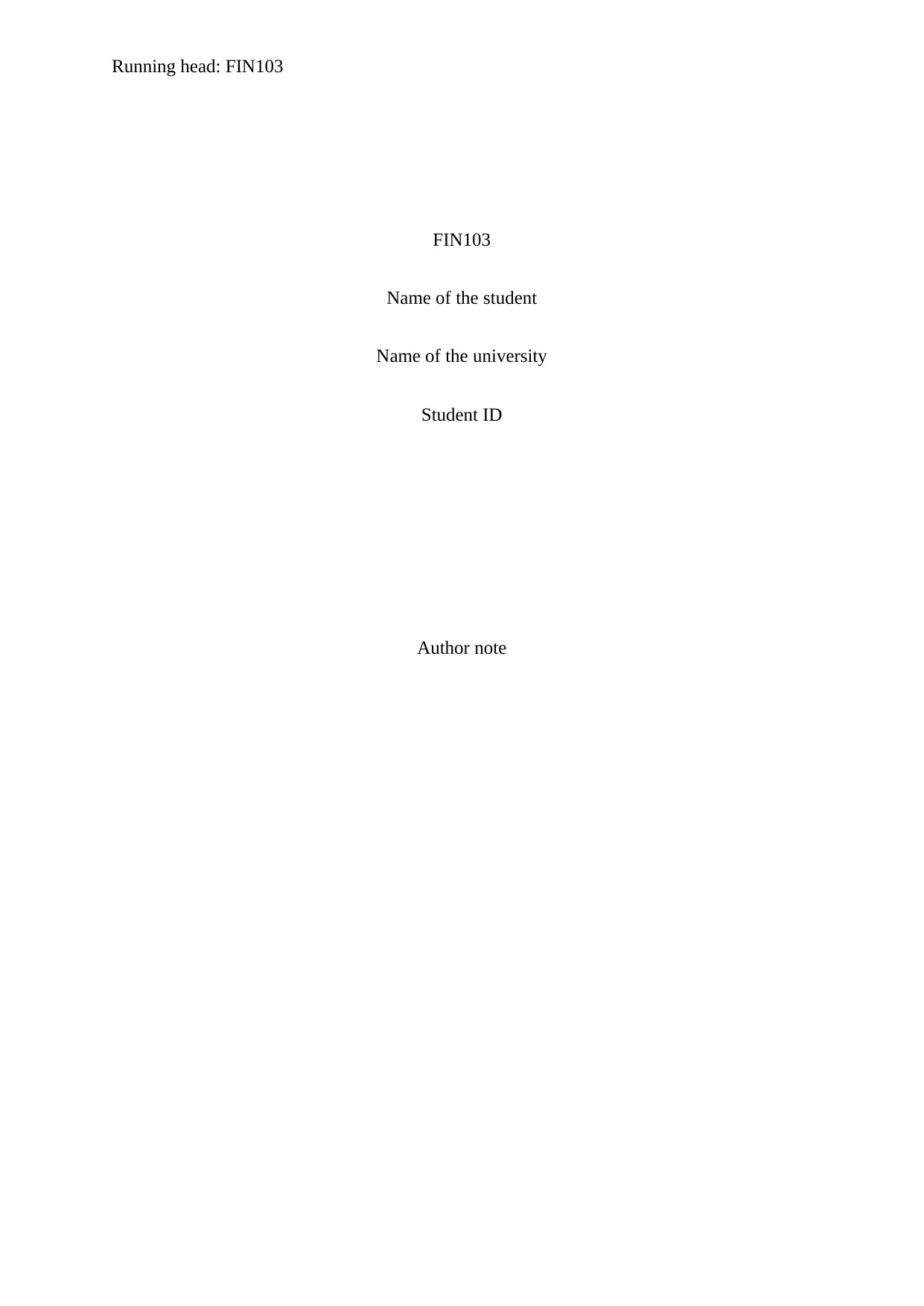
Running head: FIN103
FIN103
Name of the student
Name of the university
Student ID
Author note
FIN103
Name of the student
Name of the university
Student ID
Author note
Paraphrase This Document
Need a fresh take? Get an instant paraphrase of this document with our AI Paraphraser
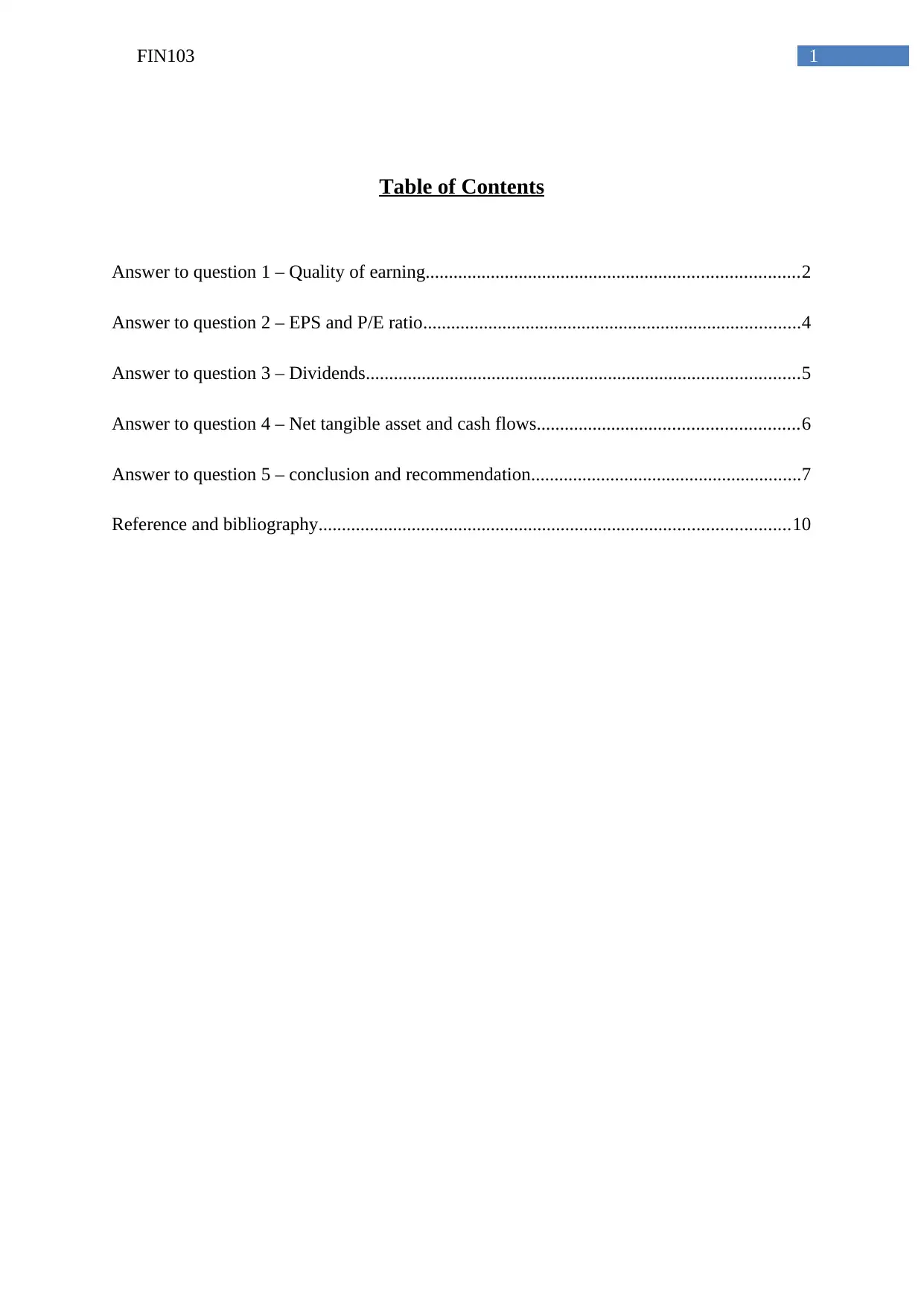
1FIN103
Table of Contents
Answer to question 1 – Quality of earning................................................................................2
Answer to question 2 – EPS and P/E ratio.................................................................................4
Answer to question 3 – Dividends.............................................................................................5
Answer to question 4 – Net tangible asset and cash flows........................................................6
Answer to question 5 – conclusion and recommendation..........................................................7
Reference and bibliography.....................................................................................................10
Table of Contents
Answer to question 1 – Quality of earning................................................................................2
Answer to question 2 – EPS and P/E ratio.................................................................................4
Answer to question 3 – Dividends.............................................................................................5
Answer to question 4 – Net tangible asset and cash flows........................................................6
Answer to question 5 – conclusion and recommendation..........................................................7
Reference and bibliography.....................................................................................................10
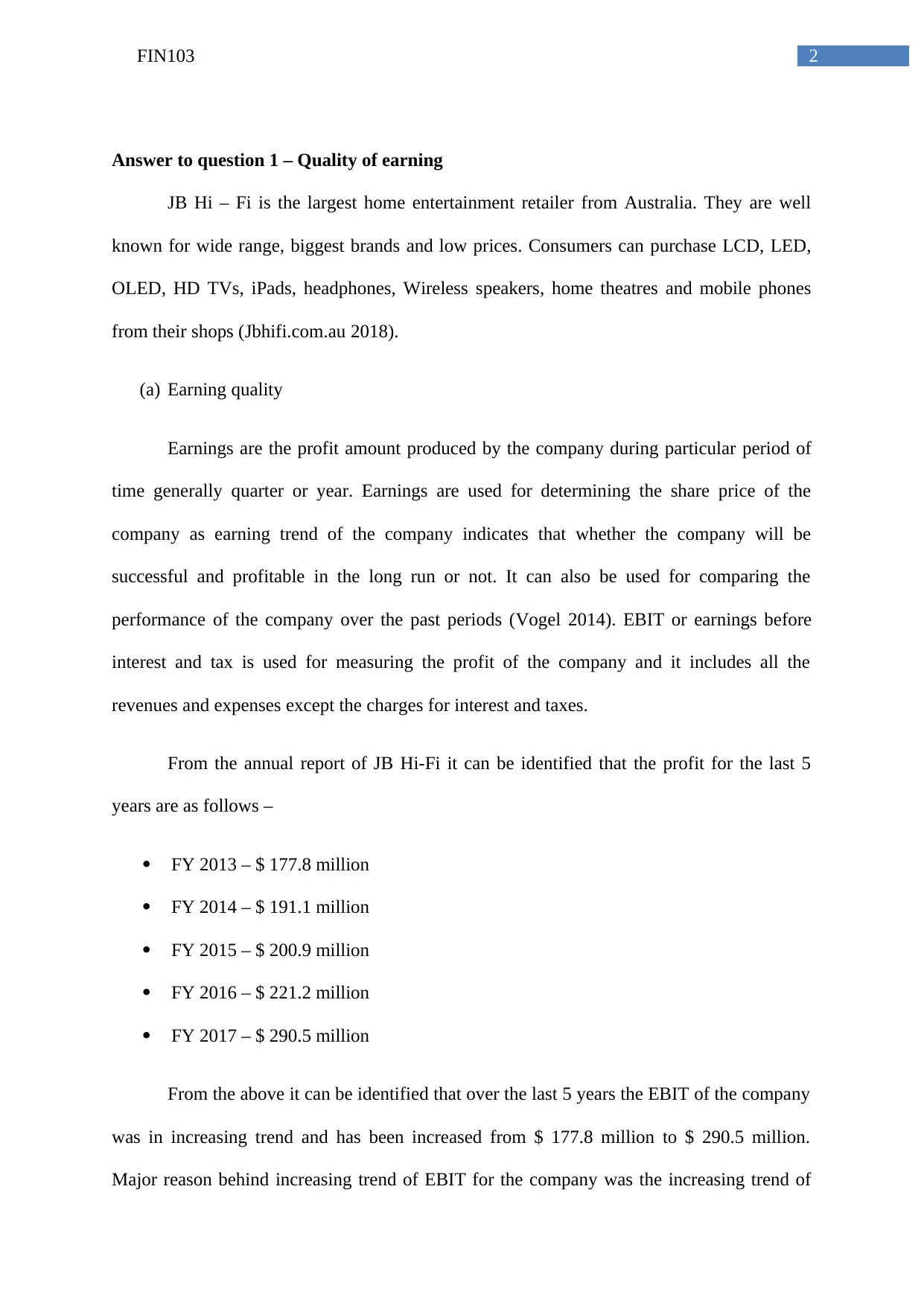
2FIN103
Answer to question 1 – Quality of earning
JB Hi – Fi is the largest home entertainment retailer from Australia. They are well
known for wide range, biggest brands and low prices. Consumers can purchase LCD, LED,
OLED, HD TVs, iPads, headphones, Wireless speakers, home theatres and mobile phones
from their shops (Jbhifi.com.au 2018).
(a) Earning quality
Earnings are the profit amount produced by the company during particular period of
time generally quarter or year. Earnings are used for determining the share price of the
company as earning trend of the company indicates that whether the company will be
successful and profitable in the long run or not. It can also be used for comparing the
performance of the company over the past periods (Vogel 2014). EBIT or earnings before
interest and tax is used for measuring the profit of the company and it includes all the
revenues and expenses except the charges for interest and taxes.
From the annual report of JB Hi-Fi it can be identified that the profit for the last 5
years are as follows –
FY 2013 – $ 177.8 million
FY 2014 – $ 191.1 million
FY 2015 – $ 200.9 million
FY 2016 – $ 221.2 million
FY 2017 – $ 290.5 million
From the above it can be identified that over the last 5 years the EBIT of the company
was in increasing trend and has been increased from $ 177.8 million to $ 290.5 million.
Major reason behind increasing trend of EBIT for the company was the increasing trend of
Answer to question 1 – Quality of earning
JB Hi – Fi is the largest home entertainment retailer from Australia. They are well
known for wide range, biggest brands and low prices. Consumers can purchase LCD, LED,
OLED, HD TVs, iPads, headphones, Wireless speakers, home theatres and mobile phones
from their shops (Jbhifi.com.au 2018).
(a) Earning quality
Earnings are the profit amount produced by the company during particular period of
time generally quarter or year. Earnings are used for determining the share price of the
company as earning trend of the company indicates that whether the company will be
successful and profitable in the long run or not. It can also be used for comparing the
performance of the company over the past periods (Vogel 2014). EBIT or earnings before
interest and tax is used for measuring the profit of the company and it includes all the
revenues and expenses except the charges for interest and taxes.
From the annual report of JB Hi-Fi it can be identified that the profit for the last 5
years are as follows –
FY 2013 – $ 177.8 million
FY 2014 – $ 191.1 million
FY 2015 – $ 200.9 million
FY 2016 – $ 221.2 million
FY 2017 – $ 290.5 million
From the above it can be identified that over the last 5 years the EBIT of the company
was in increasing trend and has been increased from $ 177.8 million to $ 290.5 million.
Major reason behind increasing trend of EBIT for the company was the increasing trend of
⊘ This is a preview!⊘
Do you want full access?
Subscribe today to unlock all pages.

Trusted by 1+ million students worldwide
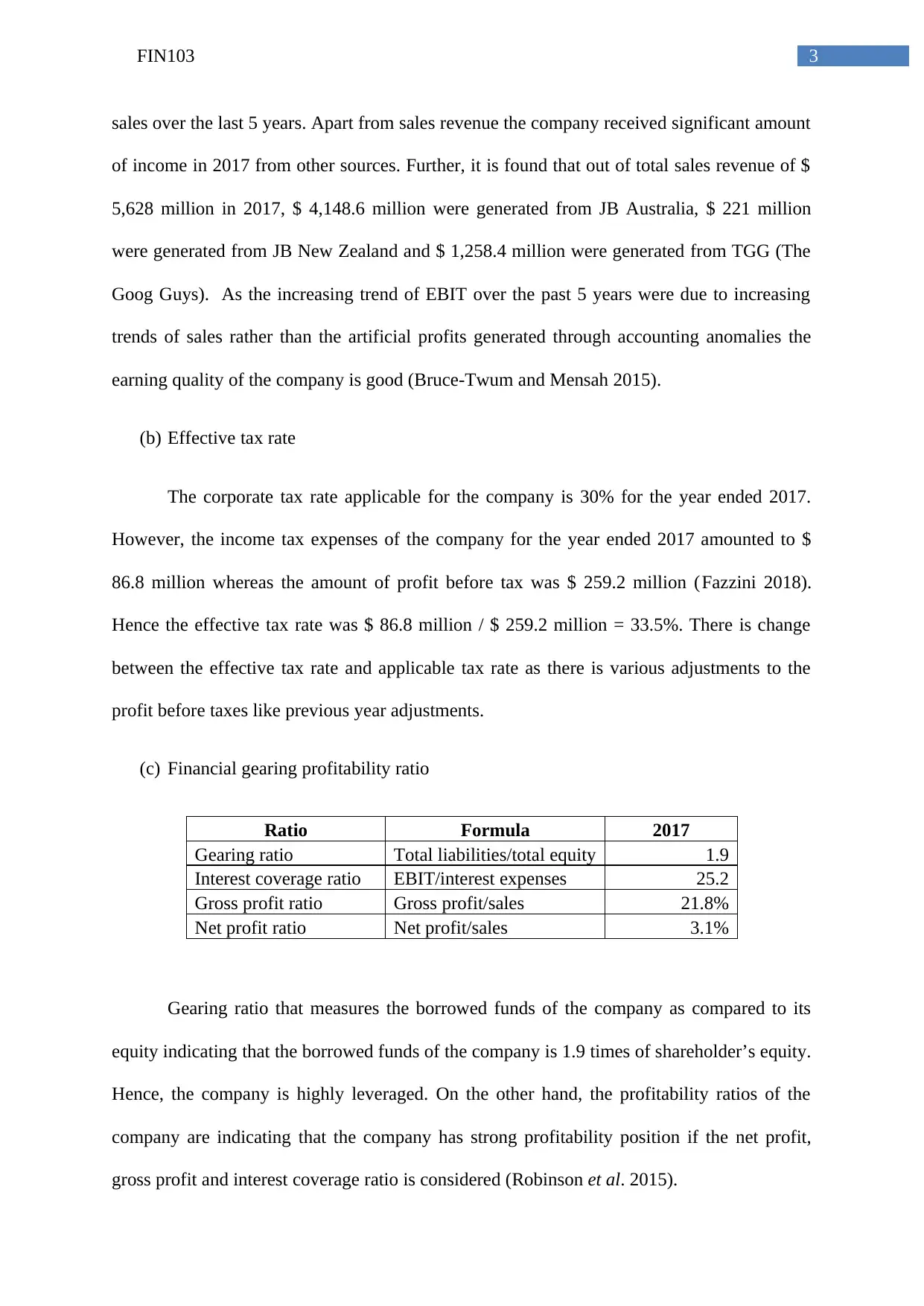
3FIN103
sales over the last 5 years. Apart from sales revenue the company received significant amount
of income in 2017 from other sources. Further, it is found that out of total sales revenue of $
5,628 million in 2017, $ 4,148.6 million were generated from JB Australia, $ 221 million
were generated from JB New Zealand and $ 1,258.4 million were generated from TGG (The
Goog Guys). As the increasing trend of EBIT over the past 5 years were due to increasing
trends of sales rather than the artificial profits generated through accounting anomalies the
earning quality of the company is good (Bruce-Twum and Mensah 2015).
(b) Effective tax rate
The corporate tax rate applicable for the company is 30% for the year ended 2017.
However, the income tax expenses of the company for the year ended 2017 amounted to $
86.8 million whereas the amount of profit before tax was $ 259.2 million (Fazzini 2018).
Hence the effective tax rate was $ 86.8 million / $ 259.2 million = 33.5%. There is change
between the effective tax rate and applicable tax rate as there is various adjustments to the
profit before taxes like previous year adjustments.
(c) Financial gearing profitability ratio
Ratio Formula 2017
Gearing ratio Total liabilities/total equity 1.9
Interest coverage ratio EBIT/interest expenses 25.2
Gross profit ratio Gross profit/sales 21.8%
Net profit ratio Net profit/sales 3.1%
Gearing ratio that measures the borrowed funds of the company as compared to its
equity indicating that the borrowed funds of the company is 1.9 times of shareholder’s equity.
Hence, the company is highly leveraged. On the other hand, the profitability ratios of the
company are indicating that the company has strong profitability position if the net profit,
gross profit and interest coverage ratio is considered (Robinson et al. 2015).
sales over the last 5 years. Apart from sales revenue the company received significant amount
of income in 2017 from other sources. Further, it is found that out of total sales revenue of $
5,628 million in 2017, $ 4,148.6 million were generated from JB Australia, $ 221 million
were generated from JB New Zealand and $ 1,258.4 million were generated from TGG (The
Goog Guys). As the increasing trend of EBIT over the past 5 years were due to increasing
trends of sales rather than the artificial profits generated through accounting anomalies the
earning quality of the company is good (Bruce-Twum and Mensah 2015).
(b) Effective tax rate
The corporate tax rate applicable for the company is 30% for the year ended 2017.
However, the income tax expenses of the company for the year ended 2017 amounted to $
86.8 million whereas the amount of profit before tax was $ 259.2 million (Fazzini 2018).
Hence the effective tax rate was $ 86.8 million / $ 259.2 million = 33.5%. There is change
between the effective tax rate and applicable tax rate as there is various adjustments to the
profit before taxes like previous year adjustments.
(c) Financial gearing profitability ratio
Ratio Formula 2017
Gearing ratio Total liabilities/total equity 1.9
Interest coverage ratio EBIT/interest expenses 25.2
Gross profit ratio Gross profit/sales 21.8%
Net profit ratio Net profit/sales 3.1%
Gearing ratio that measures the borrowed funds of the company as compared to its
equity indicating that the borrowed funds of the company is 1.9 times of shareholder’s equity.
Hence, the company is highly leveraged. On the other hand, the profitability ratios of the
company are indicating that the company has strong profitability position if the net profit,
gross profit and interest coverage ratio is considered (Robinson et al. 2015).
Paraphrase This Document
Need a fresh take? Get an instant paraphrase of this document with our AI Paraphraser
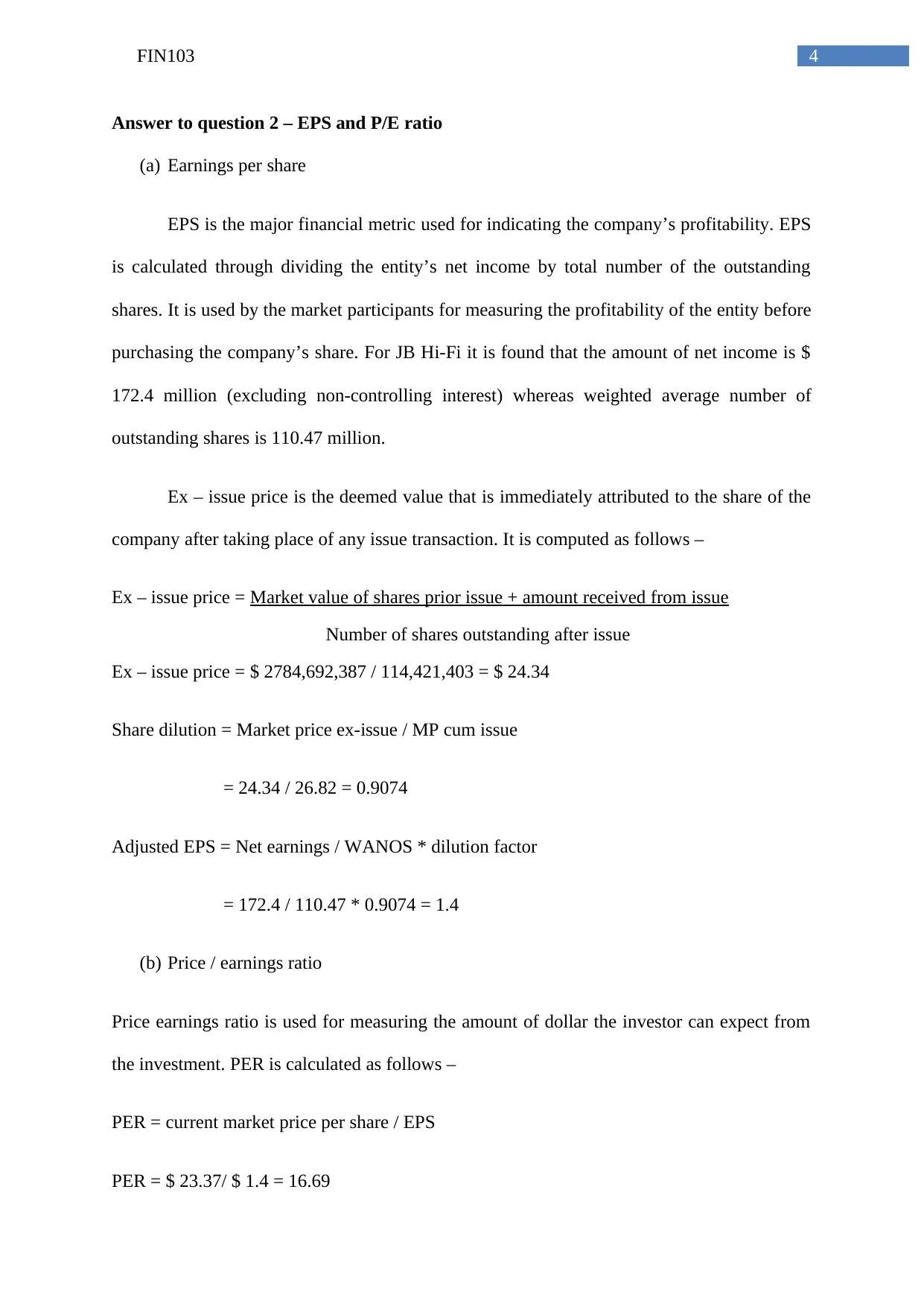
4FIN103
Answer to question 2 – EPS and P/E ratio
(a) Earnings per share
EPS is the major financial metric used for indicating the company’s profitability. EPS
is calculated through dividing the entity’s net income by total number of the outstanding
shares. It is used by the market participants for measuring the profitability of the entity before
purchasing the company’s share. For JB Hi-Fi it is found that the amount of net income is $
172.4 million (excluding non-controlling interest) whereas weighted average number of
outstanding shares is 110.47 million.
Ex – issue price is the deemed value that is immediately attributed to the share of the
company after taking place of any issue transaction. It is computed as follows –
Ex – issue price = Market value of shares prior issue + amount received from issue
Number of shares outstanding after issue
Ex – issue price = $ 2784,692,387 / 114,421,403 = $ 24.34
Share dilution = Market price ex-issue / MP cum issue
= 24.34 / 26.82 = 0.9074
Adjusted EPS = Net earnings / WANOS * dilution factor
= 172.4 / 110.47 * 0.9074 = 1.4
(b) Price / earnings ratio
Price earnings ratio is used for measuring the amount of dollar the investor can expect from
the investment. PER is calculated as follows –
PER = current market price per share / EPS
PER = $ 23.37/ $ 1.4 = 16.69
Answer to question 2 – EPS and P/E ratio
(a) Earnings per share
EPS is the major financial metric used for indicating the company’s profitability. EPS
is calculated through dividing the entity’s net income by total number of the outstanding
shares. It is used by the market participants for measuring the profitability of the entity before
purchasing the company’s share. For JB Hi-Fi it is found that the amount of net income is $
172.4 million (excluding non-controlling interest) whereas weighted average number of
outstanding shares is 110.47 million.
Ex – issue price is the deemed value that is immediately attributed to the share of the
company after taking place of any issue transaction. It is computed as follows –
Ex – issue price = Market value of shares prior issue + amount received from issue
Number of shares outstanding after issue
Ex – issue price = $ 2784,692,387 / 114,421,403 = $ 24.34
Share dilution = Market price ex-issue / MP cum issue
= 24.34 / 26.82 = 0.9074
Adjusted EPS = Net earnings / WANOS * dilution factor
= 172.4 / 110.47 * 0.9074 = 1.4
(b) Price / earnings ratio
Price earnings ratio is used for measuring the amount of dollar the investor can expect from
the investment. PER is calculated as follows –
PER = current market price per share / EPS
PER = $ 23.37/ $ 1.4 = 16.69
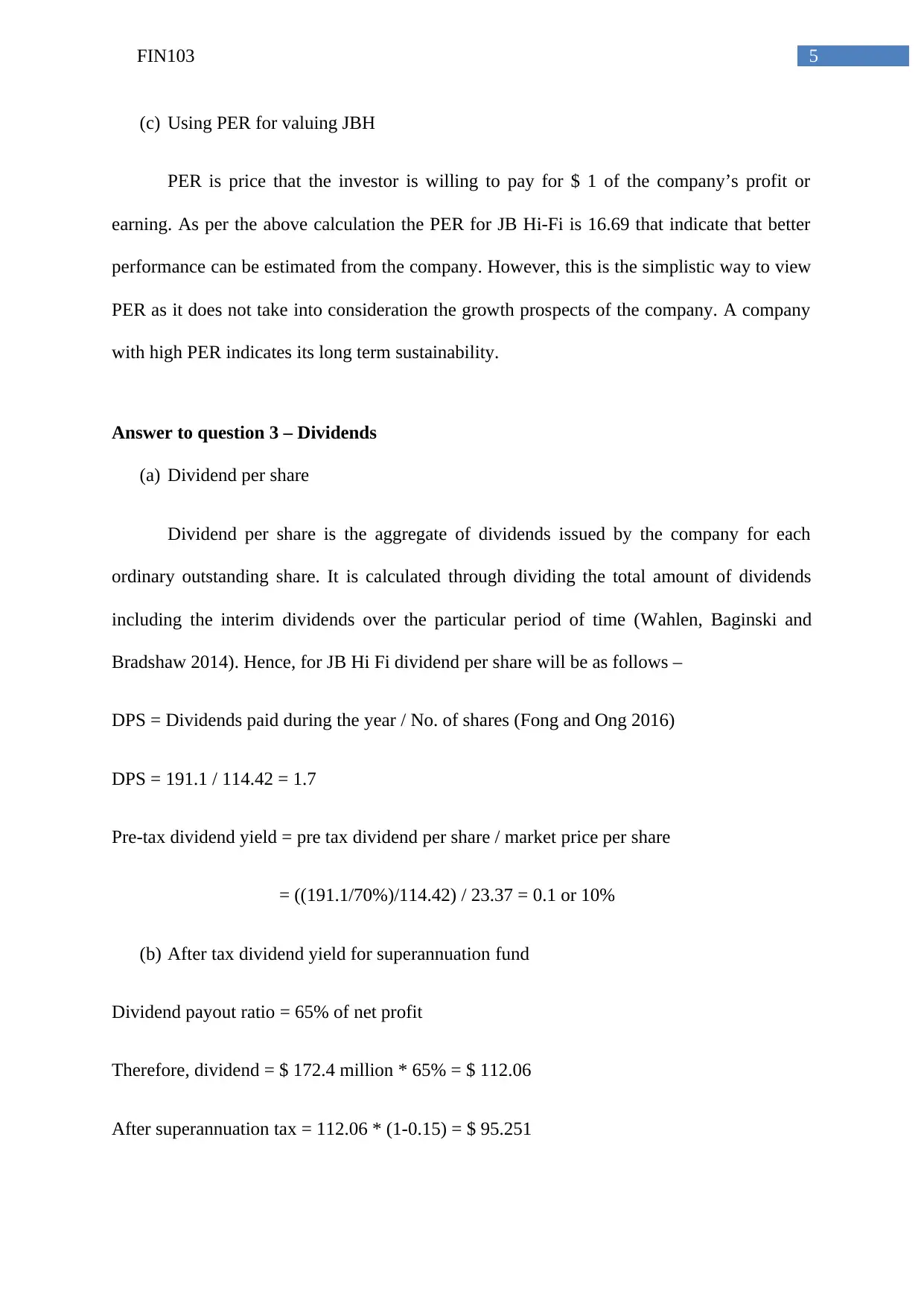
5FIN103
(c) Using PER for valuing JBH
PER is price that the investor is willing to pay for $ 1 of the company’s profit or
earning. As per the above calculation the PER for JB Hi-Fi is 16.69 that indicate that better
performance can be estimated from the company. However, this is the simplistic way to view
PER as it does not take into consideration the growth prospects of the company. A company
with high PER indicates its long term sustainability.
Answer to question 3 – Dividends
(a) Dividend per share
Dividend per share is the aggregate of dividends issued by the company for each
ordinary outstanding share. It is calculated through dividing the total amount of dividends
including the interim dividends over the particular period of time (Wahlen, Baginski and
Bradshaw 2014). Hence, for JB Hi Fi dividend per share will be as follows –
DPS = Dividends paid during the year / No. of shares (Fong and Ong 2016)
DPS = 191.1 / 114.42 = 1.7
Pre-tax dividend yield = pre tax dividend per share / market price per share
= ((191.1/70%)/114.42) / 23.37 = 0.1 or 10%
(b) After tax dividend yield for superannuation fund
Dividend payout ratio = 65% of net profit
Therefore, dividend = $ 172.4 million * 65% = $ 112.06
After superannuation tax = 112.06 * (1-0.15) = $ 95.251
(c) Using PER for valuing JBH
PER is price that the investor is willing to pay for $ 1 of the company’s profit or
earning. As per the above calculation the PER for JB Hi-Fi is 16.69 that indicate that better
performance can be estimated from the company. However, this is the simplistic way to view
PER as it does not take into consideration the growth prospects of the company. A company
with high PER indicates its long term sustainability.
Answer to question 3 – Dividends
(a) Dividend per share
Dividend per share is the aggregate of dividends issued by the company for each
ordinary outstanding share. It is calculated through dividing the total amount of dividends
including the interim dividends over the particular period of time (Wahlen, Baginski and
Bradshaw 2014). Hence, for JB Hi Fi dividend per share will be as follows –
DPS = Dividends paid during the year / No. of shares (Fong and Ong 2016)
DPS = 191.1 / 114.42 = 1.7
Pre-tax dividend yield = pre tax dividend per share / market price per share
= ((191.1/70%)/114.42) / 23.37 = 0.1 or 10%
(b) After tax dividend yield for superannuation fund
Dividend payout ratio = 65% of net profit
Therefore, dividend = $ 172.4 million * 65% = $ 112.06
After superannuation tax = 112.06 * (1-0.15) = $ 95.251
⊘ This is a preview!⊘
Do you want full access?
Subscribe today to unlock all pages.

Trusted by 1+ million students worldwide

6FIN103
Dividend yield = ($ 95.251/114.42) / 23.37 = 0.035 = 3.5% (Harris, Hartzmark and Solomon
2015)
(c) Dividend cover
Dividend cover = net income / dividend paid during the year
Dividend cover = 172.4 / 191.1 = 0.9
Answer to question 4 – Net tangible asset and cash flows
(a) NTA per share
It is calculated through dividing the net tangible asset of the company by the number
of shares outstanding. Here, net tangible assets mean total tangible assets of the company
reduced by total liabilities. It is calculated as follows –
Equity attributable to owners = $ 853.5 million
Intangible assets = $ 1026.6 million
Deferred tax assets = Nil
Adjusted equity = $ 853.5 – 1.026.6 – Nil = -$ 173.1 million
Number of shares outstanding = 111.7 million
NTA per share = - $ 173.1 / 111.7 = -$ 1.55 per share
Hence, NTA per share is in negative or shareholder does not have any tangible asset per share
as the liabilities are more than the tangible assets of the company.
(b) Evaluation of NTA against CMP
Dividend yield = ($ 95.251/114.42) / 23.37 = 0.035 = 3.5% (Harris, Hartzmark and Solomon
2015)
(c) Dividend cover
Dividend cover = net income / dividend paid during the year
Dividend cover = 172.4 / 191.1 = 0.9
Answer to question 4 – Net tangible asset and cash flows
(a) NTA per share
It is calculated through dividing the net tangible asset of the company by the number
of shares outstanding. Here, net tangible assets mean total tangible assets of the company
reduced by total liabilities. It is calculated as follows –
Equity attributable to owners = $ 853.5 million
Intangible assets = $ 1026.6 million
Deferred tax assets = Nil
Adjusted equity = $ 853.5 – 1.026.6 – Nil = -$ 173.1 million
Number of shares outstanding = 111.7 million
NTA per share = - $ 173.1 / 111.7 = -$ 1.55 per share
Hence, NTA per share is in negative or shareholder does not have any tangible asset per share
as the liabilities are more than the tangible assets of the company.
(b) Evaluation of NTA against CMP
Paraphrase This Document
Need a fresh take? Get an instant paraphrase of this document with our AI Paraphraser
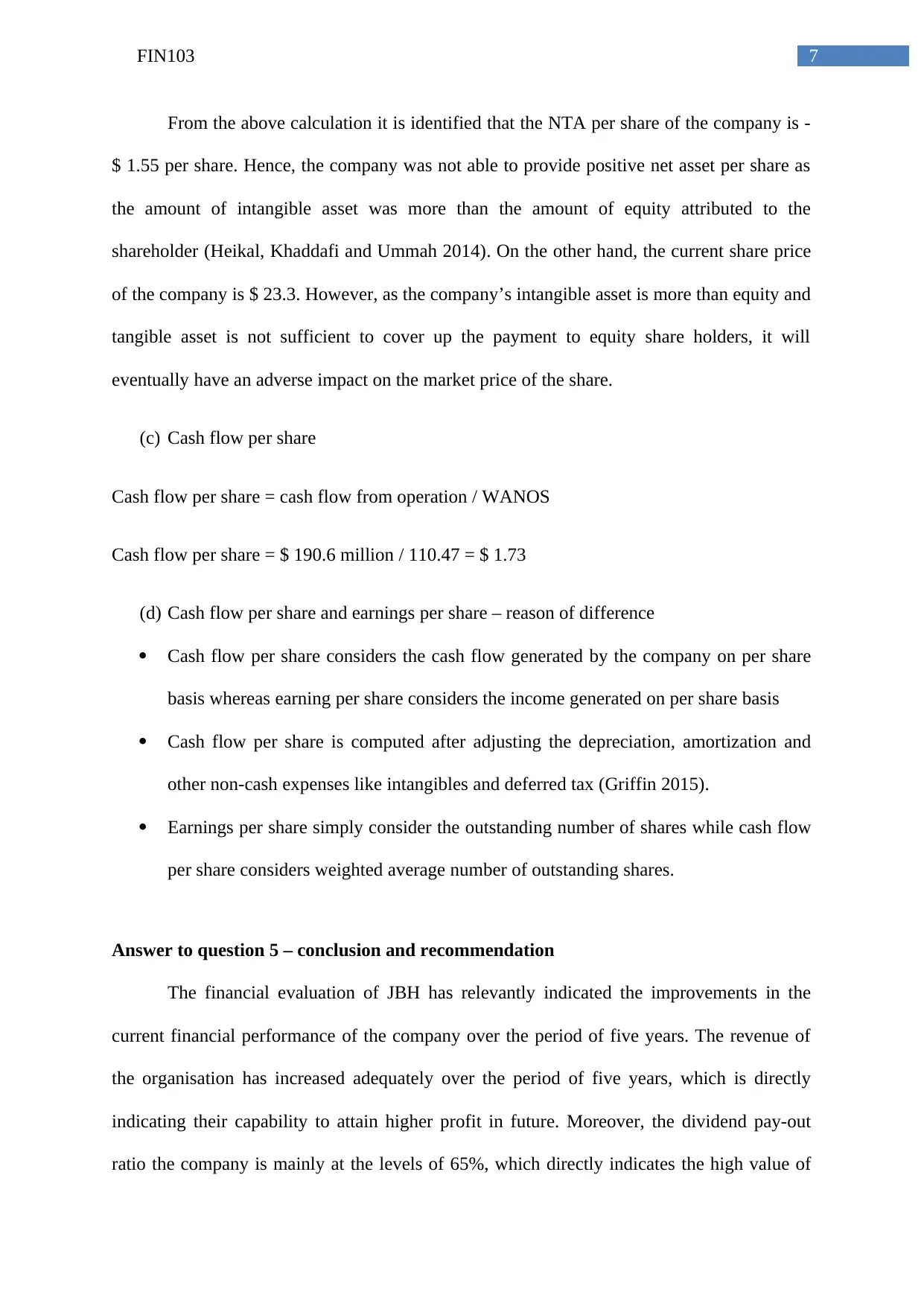
7FIN103
From the above calculation it is identified that the NTA per share of the company is -
$ 1.55 per share. Hence, the company was not able to provide positive net asset per share as
the amount of intangible asset was more than the amount of equity attributed to the
shareholder (Heikal, Khaddafi and Ummah 2014). On the other hand, the current share price
of the company is $ 23.3. However, as the company’s intangible asset is more than equity and
tangible asset is not sufficient to cover up the payment to equity share holders, it will
eventually have an adverse impact on the market price of the share.
(c) Cash flow per share
Cash flow per share = cash flow from operation / WANOS
Cash flow per share = $ 190.6 million / 110.47 = $ 1.73
(d) Cash flow per share and earnings per share – reason of difference
Cash flow per share considers the cash flow generated by the company on per share
basis whereas earning per share considers the income generated on per share basis
Cash flow per share is computed after adjusting the depreciation, amortization and
other non-cash expenses like intangibles and deferred tax (Griffin 2015).
Earnings per share simply consider the outstanding number of shares while cash flow
per share considers weighted average number of outstanding shares.
Answer to question 5 – conclusion and recommendation
The financial evaluation of JBH has relevantly indicated the improvements in the
current financial performance of the company over the period of five years. The revenue of
the organisation has increased adequately over the period of five years, which is directly
indicating their capability to attain higher profit in future. Moreover, the dividend pay-out
ratio the company is mainly at the levels of 65%, which directly indicates the high value of
From the above calculation it is identified that the NTA per share of the company is -
$ 1.55 per share. Hence, the company was not able to provide positive net asset per share as
the amount of intangible asset was more than the amount of equity attributed to the
shareholder (Heikal, Khaddafi and Ummah 2014). On the other hand, the current share price
of the company is $ 23.3. However, as the company’s intangible asset is more than equity and
tangible asset is not sufficient to cover up the payment to equity share holders, it will
eventually have an adverse impact on the market price of the share.
(c) Cash flow per share
Cash flow per share = cash flow from operation / WANOS
Cash flow per share = $ 190.6 million / 110.47 = $ 1.73
(d) Cash flow per share and earnings per share – reason of difference
Cash flow per share considers the cash flow generated by the company on per share
basis whereas earning per share considers the income generated on per share basis
Cash flow per share is computed after adjusting the depreciation, amortization and
other non-cash expenses like intangibles and deferred tax (Griffin 2015).
Earnings per share simply consider the outstanding number of shares while cash flow
per share considers weighted average number of outstanding shares.
Answer to question 5 – conclusion and recommendation
The financial evaluation of JBH has relevantly indicated the improvements in the
current financial performance of the company over the period of five years. The revenue of
the organisation has increased adequately over the period of five years, which is directly
indicating their capability to attain higher profit in future. Moreover, the dividend pay-out
ratio the company is mainly at the levels of 65%, which directly indicates the high value of
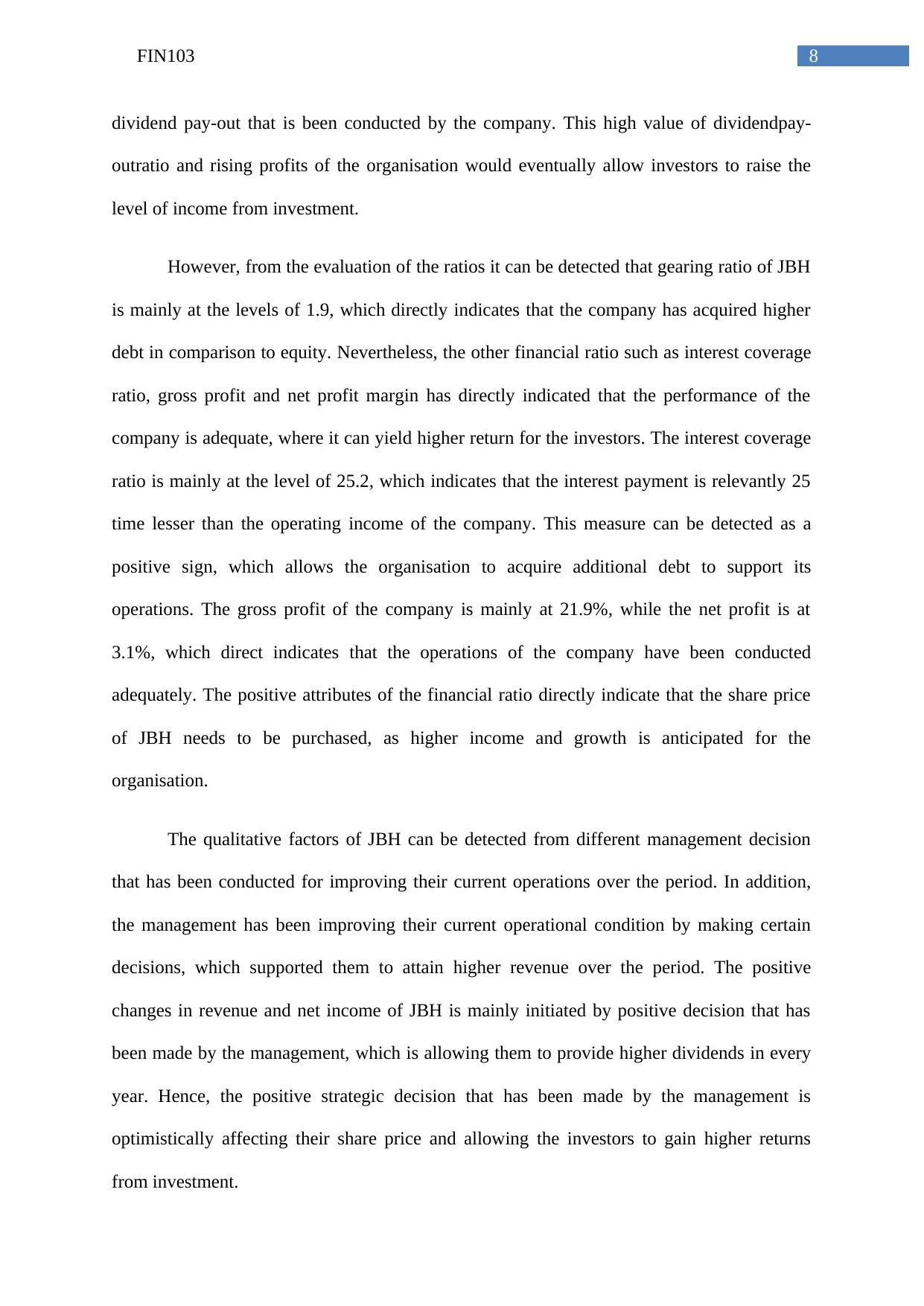
8FIN103
dividend pay-out that is been conducted by the company. This high value of dividendpay-
outratio and rising profits of the organisation would eventually allow investors to raise the
level of income from investment.
However, from the evaluation of the ratios it can be detected that gearing ratio of JBH
is mainly at the levels of 1.9, which directly indicates that the company has acquired higher
debt in comparison to equity. Nevertheless, the other financial ratio such as interest coverage
ratio, gross profit and net profit margin has directly indicated that the performance of the
company is adequate, where it can yield higher return for the investors. The interest coverage
ratio is mainly at the level of 25.2, which indicates that the interest payment is relevantly 25
time lesser than the operating income of the company. This measure can be detected as a
positive sign, which allows the organisation to acquire additional debt to support its
operations. The gross profit of the company is mainly at 21.9%, while the net profit is at
3.1%, which direct indicates that the operations of the company have been conducted
adequately. The positive attributes of the financial ratio directly indicate that the share price
of JBH needs to be purchased, as higher income and growth is anticipated for the
organisation.
The qualitative factors of JBH can be detected from different management decision
that has been conducted for improving their current operations over the period. In addition,
the management has been improving their current operational condition by making certain
decisions, which supported them to attain higher revenue over the period. The positive
changes in revenue and net income of JBH is mainly initiated by positive decision that has
been made by the management, which is allowing them to provide higher dividends in every
year. Hence, the positive strategic decision that has been made by the management is
optimistically affecting their share price and allowing the investors to gain higher returns
from investment.
dividend pay-out that is been conducted by the company. This high value of dividendpay-
outratio and rising profits of the organisation would eventually allow investors to raise the
level of income from investment.
However, from the evaluation of the ratios it can be detected that gearing ratio of JBH
is mainly at the levels of 1.9, which directly indicates that the company has acquired higher
debt in comparison to equity. Nevertheless, the other financial ratio such as interest coverage
ratio, gross profit and net profit margin has directly indicated that the performance of the
company is adequate, where it can yield higher return for the investors. The interest coverage
ratio is mainly at the level of 25.2, which indicates that the interest payment is relevantly 25
time lesser than the operating income of the company. This measure can be detected as a
positive sign, which allows the organisation to acquire additional debt to support its
operations. The gross profit of the company is mainly at 21.9%, while the net profit is at
3.1%, which direct indicates that the operations of the company have been conducted
adequately. The positive attributes of the financial ratio directly indicate that the share price
of JBH needs to be purchased, as higher income and growth is anticipated for the
organisation.
The qualitative factors of JBH can be detected from different management decision
that has been conducted for improving their current operations over the period. In addition,
the management has been improving their current operational condition by making certain
decisions, which supported them to attain higher revenue over the period. The positive
changes in revenue and net income of JBH is mainly initiated by positive decision that has
been made by the management, which is allowing them to provide higher dividends in every
year. Hence, the positive strategic decision that has been made by the management is
optimistically affecting their share price and allowing the investors to gain higher returns
from investment.
⊘ This is a preview!⊘
Do you want full access?
Subscribe today to unlock all pages.

Trusted by 1+ million students worldwide
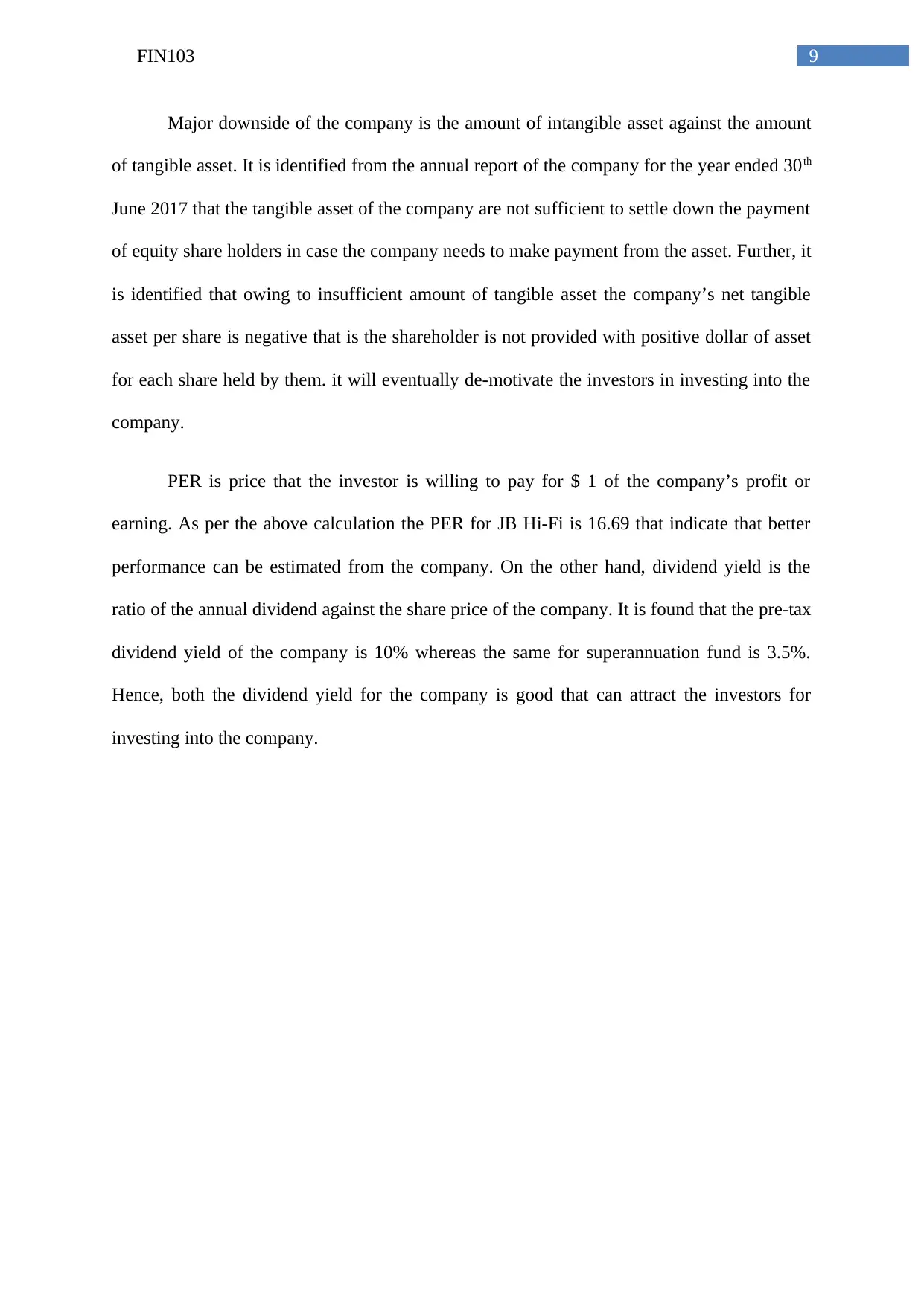
9FIN103
Major downside of the company is the amount of intangible asset against the amount
of tangible asset. It is identified from the annual report of the company for the year ended 30th
June 2017 that the tangible asset of the company are not sufficient to settle down the payment
of equity share holders in case the company needs to make payment from the asset. Further, it
is identified that owing to insufficient amount of tangible asset the company’s net tangible
asset per share is negative that is the shareholder is not provided with positive dollar of asset
for each share held by them. it will eventually de-motivate the investors in investing into the
company.
PER is price that the investor is willing to pay for $ 1 of the company’s profit or
earning. As per the above calculation the PER for JB Hi-Fi is 16.69 that indicate that better
performance can be estimated from the company. On the other hand, dividend yield is the
ratio of the annual dividend against the share price of the company. It is found that the pre-tax
dividend yield of the company is 10% whereas the same for superannuation fund is 3.5%.
Hence, both the dividend yield for the company is good that can attract the investors for
investing into the company.
Major downside of the company is the amount of intangible asset against the amount
of tangible asset. It is identified from the annual report of the company for the year ended 30th
June 2017 that the tangible asset of the company are not sufficient to settle down the payment
of equity share holders in case the company needs to make payment from the asset. Further, it
is identified that owing to insufficient amount of tangible asset the company’s net tangible
asset per share is negative that is the shareholder is not provided with positive dollar of asset
for each share held by them. it will eventually de-motivate the investors in investing into the
company.
PER is price that the investor is willing to pay for $ 1 of the company’s profit or
earning. As per the above calculation the PER for JB Hi-Fi is 16.69 that indicate that better
performance can be estimated from the company. On the other hand, dividend yield is the
ratio of the annual dividend against the share price of the company. It is found that the pre-tax
dividend yield of the company is 10% whereas the same for superannuation fund is 3.5%.
Hence, both the dividend yield for the company is good that can attract the investors for
investing into the company.
Paraphrase This Document
Need a fresh take? Get an instant paraphrase of this document with our AI Paraphraser

10FIN103
Reference and bibliography
Bruce-Twum, E. and Mensah, C.C., 2015. Financial Statement Analysis.
Fazzini, M., 2018. Financial Statement Analysis. In Business Valuation (pp. 39-76). Palgrave
Macmillan, Cham.
Fong, W.M. and Ong, Z.H., 2016. The profitable dividend yield strategy. The Journal of
Investment Management.
Griffin, P.A., 2015. Financial Statement Analysis. Finding Alphas: A Quantitative Approach
to Building Trading Strategies, pp.119-125.
Harris, L.E., Hartzmark, S.M. and Solomon, D.H., 2015. Juicing the dividend yield: Mutual
funds and the demand for dividends. Journal of Financial Economics, 116(3), pp.433-451.
Heikal, M., Khaddafi, M. and Ummah, A., 2014. Influence analysis of return on assets
(ROA), return on equity (ROE), net profit margin (NPM), debt to equity ratio (DER), and
current ratio (CR), against corporate profit growth in automotive in Indonesia Stock
Exchange. International Journal of Academic Research in Business and Social
Sciences, 4(12), p.101.
Jbhifi.com.au. 2018. JB Hi-Fi | JB Hi-Fi - Australia's Largest Home Entertainment Retailer.
[online] Available at: https://www.jbhifi.com.au/ [Accessed 19 Nov. 2018].
Laitinen, E.K., Lukason, O. and Suvas, A., 2014. Behaviour of financial ratios in firm failure
process: an international comparison. International journal of finance and accounting, 3(2),
pp.122-131.
Reference and bibliography
Bruce-Twum, E. and Mensah, C.C., 2015. Financial Statement Analysis.
Fazzini, M., 2018. Financial Statement Analysis. In Business Valuation (pp. 39-76). Palgrave
Macmillan, Cham.
Fong, W.M. and Ong, Z.H., 2016. The profitable dividend yield strategy. The Journal of
Investment Management.
Griffin, P.A., 2015. Financial Statement Analysis. Finding Alphas: A Quantitative Approach
to Building Trading Strategies, pp.119-125.
Harris, L.E., Hartzmark, S.M. and Solomon, D.H., 2015. Juicing the dividend yield: Mutual
funds and the demand for dividends. Journal of Financial Economics, 116(3), pp.433-451.
Heikal, M., Khaddafi, M. and Ummah, A., 2014. Influence analysis of return on assets
(ROA), return on equity (ROE), net profit margin (NPM), debt to equity ratio (DER), and
current ratio (CR), against corporate profit growth in automotive in Indonesia Stock
Exchange. International Journal of Academic Research in Business and Social
Sciences, 4(12), p.101.
Jbhifi.com.au. 2018. JB Hi-Fi | JB Hi-Fi - Australia's Largest Home Entertainment Retailer.
[online] Available at: https://www.jbhifi.com.au/ [Accessed 19 Nov. 2018].
Laitinen, E.K., Lukason, O. and Suvas, A., 2014. Behaviour of financial ratios in firm failure
process: an international comparison. International journal of finance and accounting, 3(2),
pp.122-131.
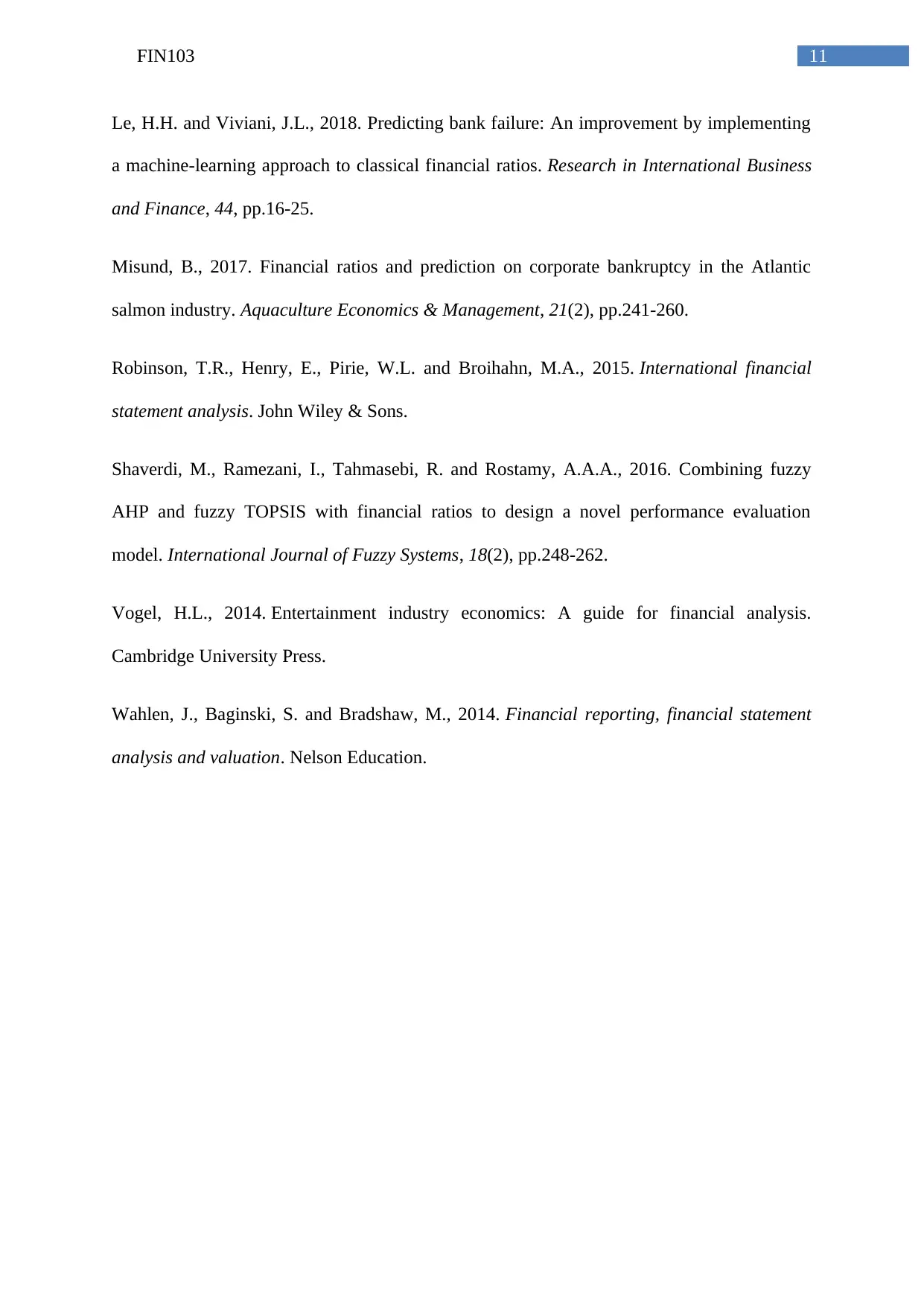
11FIN103
Le, H.H. and Viviani, J.L., 2018. Predicting bank failure: An improvement by implementing
a machine-learning approach to classical financial ratios. Research in International Business
and Finance, 44, pp.16-25.
Misund, B., 2017. Financial ratios and prediction on corporate bankruptcy in the Atlantic
salmon industry. Aquaculture Economics & Management, 21(2), pp.241-260.
Robinson, T.R., Henry, E., Pirie, W.L. and Broihahn, M.A., 2015. International financial
statement analysis. John Wiley & Sons.
Shaverdi, M., Ramezani, I., Tahmasebi, R. and Rostamy, A.A.A., 2016. Combining fuzzy
AHP and fuzzy TOPSIS with financial ratios to design a novel performance evaluation
model. International Journal of Fuzzy Systems, 18(2), pp.248-262.
Vogel, H.L., 2014. Entertainment industry economics: A guide for financial analysis.
Cambridge University Press.
Wahlen, J., Baginski, S. and Bradshaw, M., 2014. Financial reporting, financial statement
analysis and valuation. Nelson Education.
Le, H.H. and Viviani, J.L., 2018. Predicting bank failure: An improvement by implementing
a machine-learning approach to classical financial ratios. Research in International Business
and Finance, 44, pp.16-25.
Misund, B., 2017. Financial ratios and prediction on corporate bankruptcy in the Atlantic
salmon industry. Aquaculture Economics & Management, 21(2), pp.241-260.
Robinson, T.R., Henry, E., Pirie, W.L. and Broihahn, M.A., 2015. International financial
statement analysis. John Wiley & Sons.
Shaverdi, M., Ramezani, I., Tahmasebi, R. and Rostamy, A.A.A., 2016. Combining fuzzy
AHP and fuzzy TOPSIS with financial ratios to design a novel performance evaluation
model. International Journal of Fuzzy Systems, 18(2), pp.248-262.
Vogel, H.L., 2014. Entertainment industry economics: A guide for financial analysis.
Cambridge University Press.
Wahlen, J., Baginski, S. and Bradshaw, M., 2014. Financial reporting, financial statement
analysis and valuation. Nelson Education.
⊘ This is a preview!⊘
Do you want full access?
Subscribe today to unlock all pages.

Trusted by 1+ million students worldwide
1 out of 12
Related Documents
Your All-in-One AI-Powered Toolkit for Academic Success.
+13062052269
info@desklib.com
Available 24*7 on WhatsApp / Email
![[object Object]](/_next/static/media/star-bottom.7253800d.svg)
Unlock your academic potential
© 2024 | Zucol Services PVT LTD | All rights reserved.





